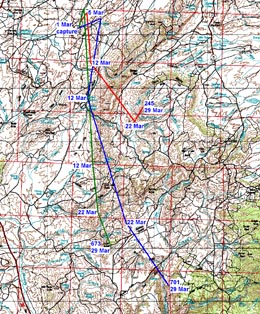






powered by SignMyGuestbook.com

| Newest
Older Previous Next Random Contact Profile Host |
blizzard warnings - 13:52 , 03 October 2013 heelerless - 21:32 , 18 August 2013 Red Coat Inn in Fort McLeod - 11:38 , 23 June 2013 rushing into the waters - 09:53 , 21 June 2013 choosing a spot - 17:43 , 27 April 2013 |
migrating elk
A month ago we had the helicopter mugging crew snatch three elk on the winter range from the air, and bolt radio collars on them. Basically, they hovered above the critter and shot a weighted net down over it, then the muggers lept out to wrestle it down, bolt on the collar (and remembered that all important step of popping off the magnet on the side of the radio so it would activate... some have forgotten that step in the past), unwrap the elk from the net, and then jump back onto the chopper.
We asked that they try to pick elk from three different herds. When you only get to sample three animals out of a couple hundred, you want them to be representative as possible. You don't want a couple of those radios following alongside each other.
Unless, of course, that's what all the elk do. But they won't.
At first, I wasn't too happy with what the chopper crew did for us. The pilot handed me three scraps of paper from a pocket spiral notebook, with the GPS coordinates of an elk capture scribbled on each page in ink from a huge marker pen. Plotted the coordinates (digitally, of course), and found they had grabbed elk all within a mile of each other.
Craaap. We'll have three radios in the same little bunch, and know nothing about everybody else.
The local warden, however, was not concerned. He'd flown with the helicopter crew over the winter range, and pointed out that all the elk were right there. In that square mile. There were no other herds to sample.
Okay. We'll wait and see.
Well, the waiting is pretty much done.
The helicopter crew did a great job for us.
When the roughly 175-200 survivors of the lichen-poisoning incident headed to summer ranges, they left in three main herds.
And we had a radio in each herd.
Alriiiight.
So, in the past month, where have they gone?
See for yourself.

Look at number 673, the green line, first.
We were most excited by her first move, which was only a few miles to the north, when a spring snowstorm hit and all the elk moved back further into the winter range. 673 is a yearling cow, meaning she'll be two years old in a month or so. And probably pregnant right now, for the first time.
A new mother.
And this would be only her second spring migration. But we were especially concerned about her because the helicopter pilot and muggers reported she was slow getting up after her capture. We were seriously concerned that she may have been in the early stages of our Red Rim malady, which we now know was lichen poisoning, and wasn't going to make it.
So her first relocation on 5 March was a real relief. Her second, on the 12th of March, was even more exciting. She, and the 50-60 elk with her, had traveled the farthest, moving at least eighteen miles in that week. (Just for reference, the red squares on the map are townships, six miles on a side).
She and her companions continued their southward movement in the following 17 days, the flight on 29 March finding her about 25 miles south of where she was marked.
Number 701, the blue line, and her 70-80 companions were a little slower to get started, but they made up for lost time by covering about 15 miles between the 12th and 22nd of March. Now, this may sound like they were really truckin', but I've watched elk cover eight miles in just a few hours, without being in any panic, so this really is a leisurely spring stroll.
Just a stroll with purpose. Pilot reported her band was all strung out in a line, busy moving south when he found her on the 22nd. As of the 29th, she was just 13 miles from your state. There is always the possibility that she, or even 673, may cross that imaginary state line.
The third elk, number 245 (the red line), has moved the least and, at least so far, appears to be a resident of the herd that lives yearlong in this part of the country. She and her 50-60 companions hopped over, or through, the steep rocky rim where they would normally winter, and crossed the area near Jim's pass to get up near the Continental Divide. Her short movement from the 22nd to the 29th, and northeasterly at that, suggests she is near home and where she wants to calve out, and is probably just following the snowline now.
We should get at least one more relocation next week, and then if everybody has settled down, flights will be dropped back to once or twice a month for the summer. And then, even more interesting, will be the fall migration, when we get to see if these girls come back.